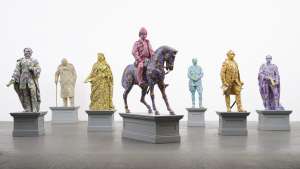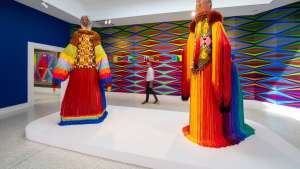Kurt Minnaar, a maths teacher from Cape Town, became a regular fixture in the country’s national headlines just over a year ago. He’d devised a way to teach mathematics to high school kids using rap, dance and visual art, and he had seen good results.
“A square number is a number times [multiplied by] itself, right? That’s what I was taught. But I was the kid that had to question it and my teachers couldn’t always answer me,” he says as he begins to illustrate the relationship between odd and square numbers with a pen and pad.
“Then I learned that odd numbers equal square numbers, and it started making sense. The first odd number is one right? What’s the first square number? What’s the second odd number? It’s 3, right? That completes the square. What’s the next odd number?

“You see, it becomes this beautiful pattern. And now it makes sense. For the type of kid I was... I needed to see it.”
This kind of tactile, visual and physical learning isn’t widely practiced in South African institutions, many of which are overburdened and under resourced.
The country’s primary education system was rated 126 out of 138 countries in the World Economic Forum 2016-2017 Global Competitiveness Report. Higher education and training institutions placed at 134.
As for the literacy rate, things are looking just as bleak. Last year, the University of Pretoria reported that 8 out of 10 grade 4 pupils still can’t read at an appropriate level.
This statistic is particularly jarring because from Grades 1 to 3 pupils are taught to read, and from Grades 4 to 12 pupils read to learn.
“The grade 8 kids come with Grade 3 and Grade 4 knowledge,” explains Minnaar. “There was one kid who struggled with basic reading and I needed to teach this kid what x is and what a variable is… like, really?”
The traditional curriculum and teaching style, he says, aren’t geared to adapt the constraints of the learning environment. Instead, teachers and pupils are running a rat race from lesson to assessment and back.
Pupils are not afforded enough time to learn new concepts, and teachers are not afforded enough time to get creative in the classroom. Essentially, it serves the independent learner only – many of whom are the minority in classrooms that are sometimes larger than 40 pupils at any given time.
The unflinching teaching cycle took its toll on Minnaar when he was a new teacher at Eben Dönges High School in Kraaifontein. He had started his career teaching like the teachers he once despised, something he never imagined he’d do.
The youngest son to two “incredible” teachers, Minnaar was preceded by a brother who now has a doctorate in mechatronics and a sister with multiple degrees. “And then I came along…” he says jokingly.
He struggled with maths in high school and dropped out of two universities before settling on entrepreneurship, I.T, maths. Dropping I.T, he noticed his grasp of mathematics had drastically improved since his struggle at high school.
It made him question his past relationship with the subject: Was he to blame? His school or his teachers? In any event, the realisation prompted him to try his hand at teaching, and like most young teachers, his expectations were grand: “I thought, ‘I’m going to come in and change the education system.’”
It wasn’t long before what he calls the “monstrous” side of the education system threatened to snuff out his enthusiasm.
“It became real when I saw how much the kids were struggling. When you sit there and you go: ‘I’m doing the same thing over and over but it’s not working’ but yet this system, this cycle, is like… so much effort is put into this system even though it’s not working,” he explains.
“From a departmental point of view, we know it’s not working but we do the same thing.”
Perhaps it was the frustration of an outdated and oversaturated curriculum or his vantage point as an ex-pupil who struggled to grasp mathematics in school, but Minnaar was motivated to begin teaching on his own terms.
He had a creative side to him, one that led him Cape Town’s hip hop scene even before he became a teacher. There, he had honed his skills in rap and choreography.
He harnessed these talents to engage his pupils, teach in a way he would have wanted to be taught, and escape the monotony of the traditional talk-and-chalk teaching style.
His first experiment, a track and music video that helped hit home the concept of multiplication was a success. As his experiments progressed, he found that his learners were happier and engaged. They were also achieving higher results than before, making it easier for them to grasp tougher mathematical concepts.
No longer a teacher at Eben Dönges High School, Minnaar has since released multiple tracks and launched Dreamer Education, an organisation with a vision to design supplementary educational materials that benefit pupils, teachers and parents.
The materials include music, workbooks and posters that focus on addition, subtraction, multiplication and division. The content is aligned to the CAPS curriculum, the national learning policy in South Africa.
“The message stays the same but the way you deliver it changes,” he explains, adding that the organisation is determined to create teaching methods and learning aids that serve the needs of any type of visual, auditory, kinaesthetic and read-write learners.
He has since also held exhibitions and workshops in the city, bringing together teachers, creatives and students.
The artsy stuff, he says, isn’t taken seriously enough. But he concedes that all teachers can’t be expected to rap or dance. Instead, it’s about finding one’s individual flow.
“I got to the point where I was like how am I supposed to teach, how is anyone supposed to be good at what they do, when firstly they’re not allowed to be themselves.”
But, changing a deeply entrenched system and having a large-scale effect is near impossible without the buy-in of policy makers and stakeholders. For now, Minnaar plans to take his message to those policymakers, teachers and anyone who will listen.
Read more about him at his website, Dreamer Education.
More on innovative ways to teach and learn:
Successful Gamification: Luis von Ahn's Duolingo is one of the most successful language learning apps.
Education suited to a rugged environment: A education kit created by a Nairobi tech company, BRCK
An e-learning redesign: The rise of GetSmarter, an internationally recognised e-learning company







